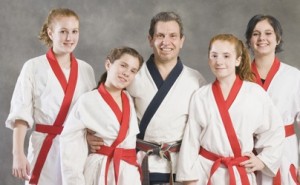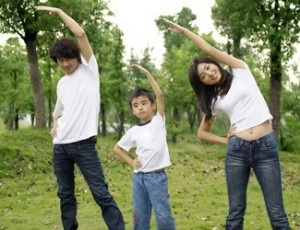 In my practice I am often asked about exercise for kids and teens. What age is exercise appropriate and what type of exercise is ideal for each age group. This seems to be a recent phenomenon since previous generations children were left to their own imaginations on what to do for play. Most small children spent time with imaginative play and as they became older they would start with more formal or informal types of sports such as baseball, soccer, swimming, etc. I recommend that children be exposed to different types of sports and allow them to choose the ones that interest them the most. Parents occasionally push their children into sports that may interest the parent but may not be developmentally appropriate or enjoyed equally by their children.
In my practice I am often asked about exercise for kids and teens. What age is exercise appropriate and what type of exercise is ideal for each age group. This seems to be a recent phenomenon since previous generations children were left to their own imaginations on what to do for play. Most small children spent time with imaginative play and as they became older they would start with more formal or informal types of sports such as baseball, soccer, swimming, etc. I recommend that children be exposed to different types of sports and allow them to choose the ones that interest them the most. Parents occasionally push their children into sports that may interest the parent but may not be developmentally appropriate or enjoyed equally by their children.
YOGA
 Yoga has been practiced in India for thousands of years and there are many forms of Yoga focusing on different types of Hindu philosophy. Physical and mental disciplines are the main benefits of Yoga. In Western societies, Yoga is practiced mainly practiced for its physical and health benefits. Practitioners believe that it helps them with mental focus and clarity. Recently there are Yoga classes for infants and young children that claim to help keep them calm and focused. There may be benefits for children with ADHD or other behavioral issues such as Autism or Asperger Syndrome but there are no studies from the United States that support these claims. There are many studies from Middle Eastern journals. Usually young children are unable to stay focused long enough to hold the poses or to participate for a full adult classes. If you’re looking for a class, try to find one where the parents participate with the children and there should be breaks and make sure it’s fun. Children like to imitate animals and poses like “downward dog” and standing like a flamingo teach them balance and strength. A great alternative is a Yoga DVDthat is made for kids. These dvds are a great introduction for kids and parents can participate. One thing is to keep in mind is that although yoga has great benefits of flexibility and balance, it is important to include cardiovascular exercise.
Yoga has been practiced in India for thousands of years and there are many forms of Yoga focusing on different types of Hindu philosophy. Physical and mental disciplines are the main benefits of Yoga. In Western societies, Yoga is practiced mainly practiced for its physical and health benefits. Practitioners believe that it helps them with mental focus and clarity. Recently there are Yoga classes for infants and young children that claim to help keep them calm and focused. There may be benefits for children with ADHD or other behavioral issues such as Autism or Asperger Syndrome but there are no studies from the United States that support these claims. There are many studies from Middle Eastern journals. Usually young children are unable to stay focused long enough to hold the poses or to participate for a full adult classes. If you’re looking for a class, try to find one where the parents participate with the children and there should be breaks and make sure it’s fun. Children like to imitate animals and poses like “downward dog” and standing like a flamingo teach them balance and strength. A great alternative is a Yoga DVDthat is made for kids. These dvds are a great introduction for kids and parents can participate. One thing is to keep in mind is that although yoga has great benefits of flexibility and balance, it is important to include cardiovascular exercise.
MARTIAL ARTS
Martial arts classes come in many forms and are quite popular with active kids. One of the more popular forms is the Korean style of Tae Kwon Do. These classes require a certain amount of attention span and focus; I would not recommend starting under 5 or 6 years of age. A good martial arts school would combine teaching respect, leadership skills, self-esteem and self-control. Parents are often afraid that their child would fight more because of the training but a good school would discourage fighting.
The physical benefits of martial arts include strength, speed, balance, cardiovascular fitness and flexibility. It is one of the sports that offer overall conditioning of the entire body. This sport does not necessarily emphasize height or size as a prerequisite to succeed like basketball or football. Many excellent martial artists are relatively small compared to athletes in other sports. For example, action star Jackie Chan is only 5’8” and Bruce Lee was only 5’6”. They used their speed, flexibility, and balance to perform their almost superhuman stunts.
Children are often put into competitive team sports but not all children enjoy or do well in these types of sports. Martial arts focus on individual skills and achieving personal growth instead of winning games for a team. If the child lags in a team sport, this may affect his or her self-esteem. In martial arts schools, how much effort is put into practice is just as important as technical skill. A good school will reward diligence rather than the number of broken boards.
Another benefit of a good martial arts school is the improvement in focus attention, and oppositional behaviors. A study titled Externalizing and oppositional behaviors and karate-do: the way of crime prevention. Another study looked at the effects of Karate training in children who were diagnosed with Oppositional Defiant Disorder. Three components of temperament–intensity, adaptability, and mood regulation–were measured at the beginning and the end of the training period. A significant improvement in temperament scale scores was measured in the karate group for all tested items compared to controls. As a practitioner and instructor I see many of the benefits but it is important that behavioral issues should be addressed in the home also.
Recently bullying at schools has been brought to the forefront because of suicides and fighting. A benefit of martial arts training is self-defense; although a good school would teach avoiding a fight, it is a skill that can be called upon if needed. Most students of martial arts have improved self-esteem because of their training and bullies tend to avoid children with good self-esteem. Bullies tend to target kids who appear weaker and are unable to fight back.
When looking for a school, look for an instructor that emphasizes self-control, discipline, and conflict resolution over physical violence. Recently there has been a rise in popularity of MMA (Mixed Martial Arts). These schools usually forgo the philosophy of self-control and discipline; they are more designed for training to fight using techniques drawn from different styles of martial arts. I would not recommend this style of fighting for young children and pre-teens. There are also many schools that promise a “black belt” within a prescribed period of time. There is no such thing, because every body progresses at a different rate and achieving a “ black belt” does not guarantee a certain skill level. As a practitioner of Tae Kwon Do, I know that there is always more to learn and perfecting a technique is a lifelong endeavor.


